中山大学概况
- 格式:docx
- 大小:26.09 KB
- 文档页数:8

中大校史建校初期-->>抗日战争胜利 (光辉历程之一)1924年-1927年(建校初期)中山大学,原名广东大学,是伟大的民主主义革命家孙中山先生于1924年创办的。
为了培养革命的军事、政治干部和科学人才,孙中山在创办黄埔军校的同时,把当时的国立广东高等师范学校、广东法科大学和广东省立农业专门学校合并,创立了广东大学,任命邹鲁为校长。
广东大学下设文、理、法、农、医5科16个学系。
校本部设在广州文明路。
1925年3月,孙中山先生逝世。
廖仲恺在国民党第一届中央执委会第七十一次会议上提议将广东大学改名为中山大学,以纪念孙中山先生。
8月,广东大学校务会议正式通过改名,得到国民政府批准。
1926年7月,国民政府正式明令将广东大学改名为中山大学。
1927年-1938年1927年至1937年,中山大学各方面都有发展。
1930年9月至12月朱家骅为校长。
1931年6月至1932年1月由著名教育家许崇清任校长。
1931年设有文、法、理、农、医五个学科,同年将学科改称学院。
1932年2月后校长仍为邹鲁。
1 934年成立工学院,1935年春成立研究院,开始招收研究生。
至此,中山大学设有文、法、理、工、农、医、研7个学院,23个学系,以及天文台、各研究所、医院、中小学等主要附属单位共19个。
中山大学校园建设方面也取得了显著的成绩,在邹鲁校长等努力下,在广州市东郊白云山侧的石牌兴建了占地达12000亩的新校园。
1937年夏,广东法科学院并入中大法学院。
1938年夏,广东省立勤大学工学院并入中大工学院,1938年秋设立师范学院。
至1938年全校发展为文、理、法、工、农、医、师、研等8个学院,31学系。
1938年-45年(抗日战争时期)抗日战争期间,中山大学曾三易校址,辗转跋涉。
校舍、图书、仪器设备损失惨重。
1938年10月,日军侵入广州,中山大学初迁广东罗定,后改迁云南江。
1940年4月许崇清复任校长(代)。
同年秋,他主持由江迁校回粤北坪石。
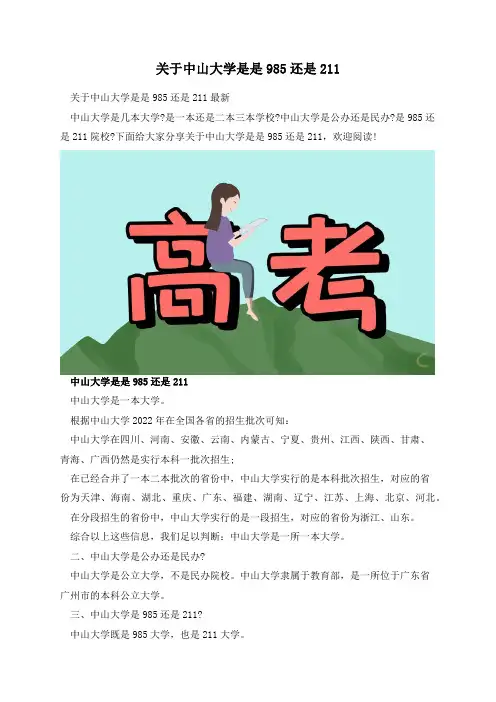
关于中山大学是是985还是211关于中山大学是是985还是211最新中山大学是几本大学?是一本还是二本三本学校?中山大学是公办还是民办?是985还是211院校?下面给大家分享关于中山大学是是985还是211,欢迎阅读!中山大学是是985还是211中山大学是一本大学。
根据中山大学2022年在全国各省的招生批次可知:中山大学在四川、河南、安徽、云南、内蒙古、宁夏、贵州、江西、陕西、甘肃、青海、广西仍然是实行本科一批次招生;在已经合并了一本二本批次的省份中,中山大学实行的是本科批次招生,对应的省份为天津、海南、湖北、重庆、广东、福建、湖南、辽宁、江苏、上海、北京、河北。
在分段招生的省份中,中山大学实行的是一段招生,对应的省份为浙江、山东。
综合以上这些信息,我们足以判断:中山大学是一所一本大学。
二、中山大学是公办还是民办?中山大学是公立大学,不是民办院校。
中山大学隶属于教育部,是一所位于广东省广州市的本科公立大学。
三、中山大学是985还是211?中山大学既是985大学,也是211大学。
根据教育部985、211高校名单可知,广东省目前一共有2所985大学,是中山大学、华南理工大学;一共有4所211大学,是华南师范大学、中山大学、华南理工大学、暨南大学。
中山大学王牌专业一名是临床医学(八年制):球场线为653点第二名是电子信息(广州,包含通信工程微电子科学与工程光电信息科学与工程专门):球场线为631点牙科医学第 3 名:球场线为630分第四名:临床医学(深圳):球场线为629点经济学第5名(珠海),与经济学、金融学专门):球场线为628点6号人工智能球场线为628点工商管理专业第7名(广州),包括工商管理、会计重大的):球场线为628点第八名是航空航天(包括航空航天工程理论与应用力学专门):球场线为622点9号化学类(包括化学高分子材料与工程专门):球场线为621点中山大学找工作最好的职业是什么?从学习的角度来看,中山大学最适合就业的专业,应该中山大学综合实力和师资最强的专业。
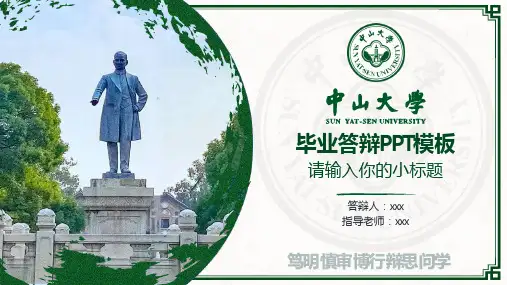
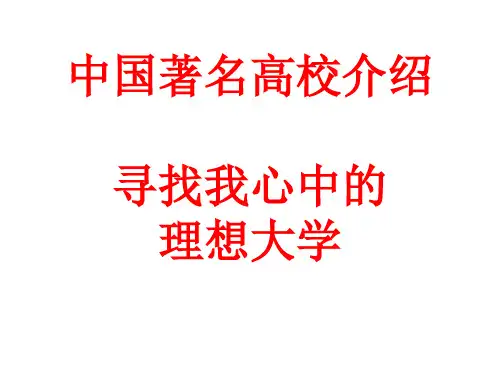
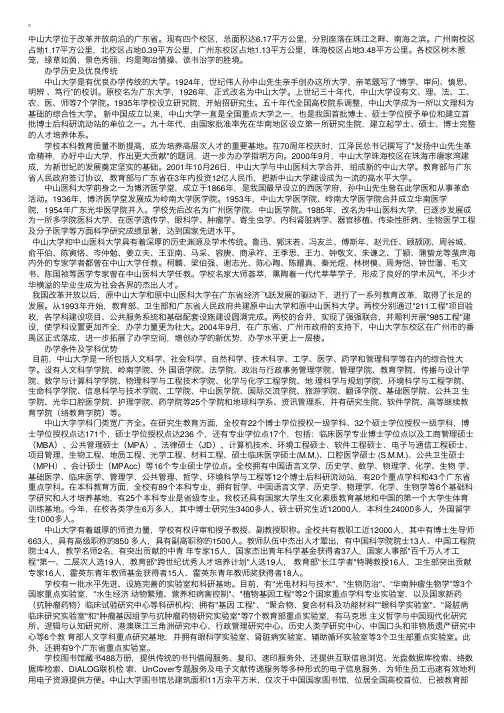
中⼭⼤学位于改⾰开放前沿的⼴东省。
现有四个校区,总⾯积达6.17平⽅公⾥,分别座落在珠江之畔、南海之滨。
⼴州南校区占地1.17平⽅公⾥,北校区占地0.39平⽅公⾥,⼴州东校区占地1.13平⽅公⾥,珠海校区占地3.48平⽅公⾥。
各校区树⽊葱笼,绿草如茵,景⾊秀丽,均是陶冶情操、读书治学的胜境。
办学历史及优良传统 中⼭⼤学是有优良办学传统的⼤学。
1924年,世纪伟⼈孙中⼭先⽣亲⼿创办这所⼤学,亲笔题写了“博学、审问、慎思、明辨、笃⾏”的校训。
原校名为⼴东⼤学,1926年,正式改名为中⼭⼤学。
上世纪三⼗年代,中⼭⼤学设有⽂、理、法、⼯、农、医、师等7个学院。
1935年学校设⽴研究院,开始招研究⽣。
五⼗年代全国⾼校院系调整,中⼭⼤学成为⼀所以⽂理科为基础的综合性⼤学。
新中国成⽴以来,中⼭⼤学⼀直是全国重点⼤学之⼀,也是我国⾸批博⼠、硕⼠学位授予单位和建⽴⾸批博⼠后科研流动站的单位之⼀。
九⼗年代,由国家批准率先在华南地区设⽴第⼀所研究⽣院,建⽴起学⼠、硕⼠、博⼠完整的⼈才培养体系。
学校本科教育质量不断提⾼,成为培养⾼层次⼈才的重要基地。
在70周年校庆时,江泽民总书记撰写了"发扬中⼭先⽣⾰命精神,办好中⼭⼤学,作出更⼤贡献"的题词,进⼀步为办学指明⽅向。
2000年9⽉,中⼭⼤学珠海校区在珠海市唐家湾建成,为新世纪的发展奠定坚实的基础。
2001年10⽉26⽇,中⼭⼤学与中⼭医科⼤学合并,组成新的中⼭⼤学。
教育部与⼴东省⼈民政府签订协议,教育部与⼴东省在3年内投资12亿⼈民币,把新中⼭⼤学建设成为⼀流的⾼⽔平⼤学。
中⼭医科⼤学前⾝之⼀为博济医学堂,成⽴于1866年,是我国最早设⽴的西医学府,孙中⼭先⽣曾在此学医和从事⾰命活动。
1936年,博济医学堂发展成为岭南⼤学医学院。
1953年,中⼭⼤学医学院、岭南⼤学医学院合并成⽴华南医学院,1954年⼴东光华医学院并⼊。
学校先后改名为⼴州医学院、中⼭医学院。
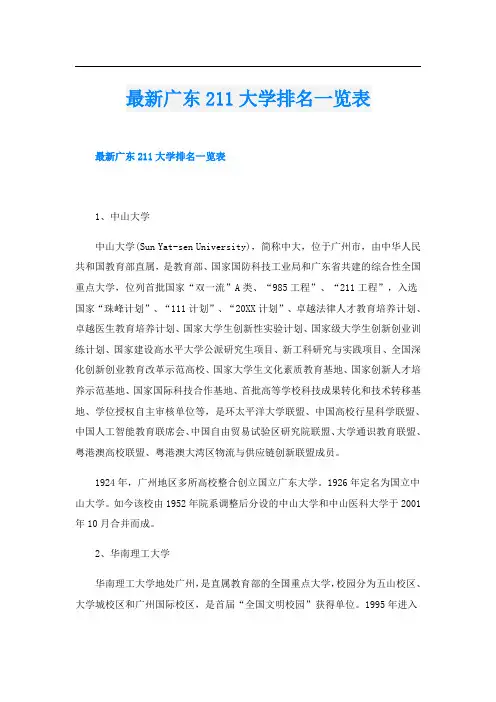
最新广东211大学排名一览表最新广东211大学排名一览表1、中山大学中山大学(Sun Yat-sen University),简称中大,位于广州市,由中华人民共和国教育部直属,是教育部、国家国防科技工业局和广东省共建的综合性全国重点大学,位列首批国家“双一流”A类、“985工程”、“211工程”,入选国家“珠峰计划”、“111计划”、“20XX计划”、卓越法律人才教育培养计划、卓越医生教育培养计划、国家大学生创新性实验计划、国家级大学生创新创业训练计划、国家建设高水平大学公派研究生项目、新工科研究与实践项目、全国深化创新创业教育改革示范高校、国家大学生文化素质教育基地、国家创新人才培养示范基地、国家国际科技合作基地、首批高等学校科技成果转化和技术转移基地、学位授权自主审核单位等,是环太平洋大学联盟、中国高校行星科学联盟、中国人工智能教育联席会、中国自由贸易试验区研究院联盟、大学通识教育联盟、粤港澳高校联盟、粤港澳大湾区物流与供应链创新联盟成员。
1924年,广州地区多所高校整合创立国立广东大学。
1926年定名为国立中山大学。
如今该校由1952年院系调整后分设的中山大学和中山医科大学于2001年10月合并而成。
2、华南理工大学华南理工大学地处广州,是直属教育部的全国重点大学,校园分为五山校区、大学城校区和广州国际校区,是首届“全国文明校园”获得单位。
1995年进入“211工程”行列;2001年进入“985工程”行列;20XX年入选“双一流”建设A 类高校名单。
如今的华南理工大学已经发展为一所以工见长,理、工、医结合,管、经、文、法等多学科协调发展的综合性研究型大学。
20XX年,华南理工大学广州国际校区由教育部、广东省、广州市和华南理工大学四方签约共建,这是学校“双一流”建设发展的新引擎,也是中国高等教育又一次新的探索。
校区采用“中方为主、国际协同”的方式,依托学校现有优势学科资源和理工特色,与牛津大学、密西根大学等不少于20所世界著名一流高校强强联合,努力办成高水平、国际化、研究型、新工科特色的世界一流示范校区。
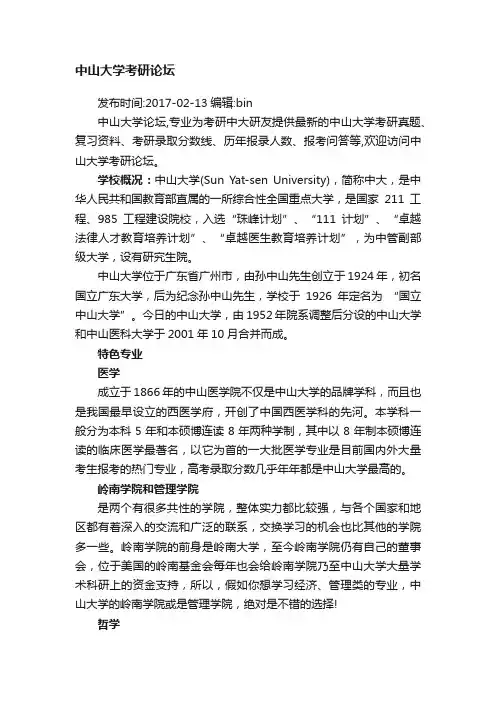
中山大学考研论坛发布时间:2017-02-13编辑:bin中山大学论坛,专业为考研中大研友提供最新的中山大学考研真题、复习资料、考研录取分数线、历年报录人数、报考问答等,欢迎访问中山大学考研论坛。
学校概况:中山大学(Sun Yat-sen University),简称中大,是中华人民共和国教育部直属的一所综合性全国重点大学,是国家211工程、985工程建设院校,入选“珠峰计划”、“111计划”、“卓越法律人才教育培养计划”、“卓越医生教育培养计划”,为中管副部级大学,设有研究生院。
中山大学位于广东省广州市,由孙中山先生创立于1924年,初名国立广东大学,后为纪念孙中山先生,学校于1926年定名为“国立中山大学”。
今日的中山大学,由1952年院系调整后分设的中山大学和中山医科大学于2001年10月合并而成。
特色专业医学成立于1866年的中山医学院不仅是中山大学的品牌学科,而且也是我国最早设立的西医学府,开创了中国西医学科的先河。
本学科一般分为本科5年和本硕博连读8年两种学制,其中以8年制本硕博连读的临床医学最著名,以它为首的一大批医学专业是目前国内外大量考生报考的热门专业,高考录取分数几乎年年都是中山大学最高的。
岭南学院和管理学院是两个有很多共性的学院,整体实力都比较强,与各个国家和地区都有着深入的交流和广泛的联系,交换学习的机会也比其他的学院多一些。
岭南学院的前身是岭南大学,至今岭南学院仍有自己的董事会,位于美国的岭南基金会每年也会给岭南学院乃至中山大学大量学术科研上的资金支持,所以,假如你想学习经济、管理类的专业,中山大学的岭南学院或是管理学院,绝对是不错的选择!哲学哲学系建立于1924年,为中山大学创建之初最早培育的院系之一,拥有中国最知名的胡塞尔研究专家刘小枫教授等知名专家们执教,名声远扬,保研率也是高达30%之多。
这些被保送的学生不仅局限于本校,而且还可以被保送到清华、北大、复旦等类似的名校。
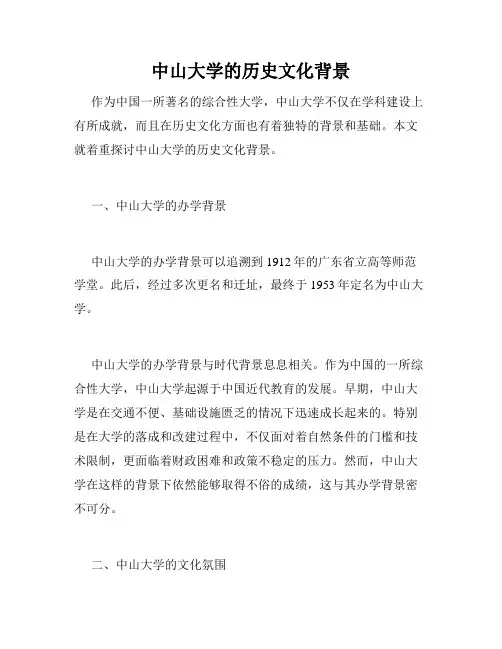
中山大学的历史文化背景作为中国一所著名的综合性大学,中山大学不仅在学科建设上有所成就,而且在历史文化方面也有着独特的背景和基础。
本文就着重探讨中山大学的历史文化背景。
一、中山大学的办学背景中山大学的办学背景可以追溯到1912年的广东省立高等师范学堂。
此后,经过多次更名和迁址,最终于1953年定名为中山大学。
中山大学的办学背景与时代背景息息相关。
作为中国的一所综合性大学,中山大学起源于中国近代教育的发展。
早期,中山大学是在交通不便、基础设施匮乏的情况下迅速成长起来的。
特别是在大学的落成和改建过程中,不仅面对着自然条件的门槛和技术限制,更面临着财政困难和政策不稳定的压力。
然而,中山大学在这样的背景下依然能够取得不俗的成绩,这与其办学背景密不可分。
二、中山大学的文化氛围中山大学是一所历史悠久、文化底蕴丰厚的大学。
校园内沉淀着大量的人文历史和学术积淀。
从校园内的建筑、艺术、书法到学术思想和学科建设,中山大学都有其独特的文化氛围。
1、建筑文化中山大学的建筑文化以西方建筑为主,融合了东方文化元素。
其中最有代表性的是纪念堂。
纪念堂是中山大学最为标志性的建筑之一,其建筑风格自然、简洁、富有艺术美感,它所体现出的人文关怀以及对民族复兴的呼唤,是中山大学建筑文化价值的真实体现。
此外,中山大学还拥有着一系列建筑风格多样的寺庙和园林。
这些建筑与中山大学西方建筑相映成趣,也是中山大学建筑文化独特的代表。
2、书法艺术中山大学书法艺术有着独特的风格和文化内涵。
在校园内,可以看到很多石碑、石刻、匾额等书法作品,这些作品都体现了中山大学书法艺术的一个重要特点——古拙。
中山大学书法艺术以简洁、自然和古拙著称。
当我们欣赏中山大学书法作品时,可以感受到其中所承载的东方文化情结,它所表达的是一种浪漫、悼念和思索的情怀。
3、学术科研中山大学作为一所综合性大学,在学术研究上也有着自己的独特风格和学术传统。
中山大学在自然科学、社会科学、人文艺术等多个领域都有着不俗的成绩和声誉。
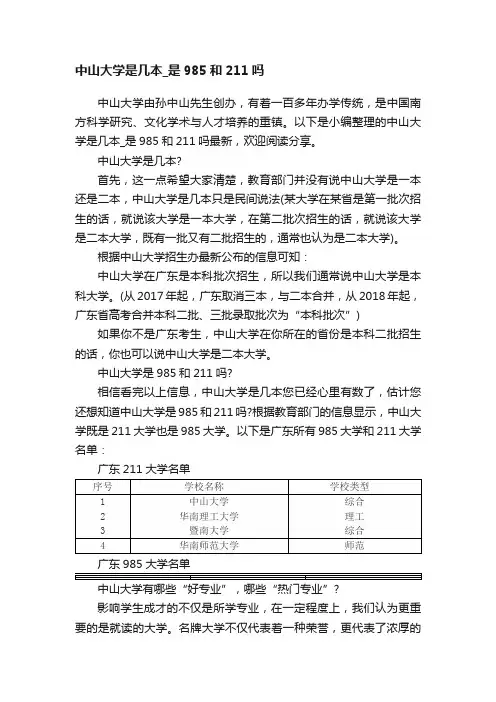
中山大学是几本_是985和211吗中山大学由孙中山先生创办,有着一百多年办学传统,是中国南方科学研究、文化学术与人才培养的重镇。
以下是小编整理的中山大学是几本_是985和211吗最新,欢迎阅读分享。
中山大学是几本?首先,这一点希望大家清楚,教育部门并没有说中山大学是一本还是二本,中山大学是几本只是民间说法(某大学在某省是第一批次招生的话,就说该大学是一本大学,在第二批次招生的话,就说该大学是二本大学,既有一批又有二批招生的,通常也认为是二本大学)。
根据中山大学招生办最新公布的信息可知:中山大学在广东是本科批次招生,所以我们通常说中山大学是本科大学。
(从2017年起,广东取消三本,与二本合并,从2018年起,广东省高考合并本科二批、三批录取批次为“本科批次”)如果你不是广东考生,中山大学在你所在的省份是本科二批招生的话,你也可以说中山大学是二本大学。
中山大学是985和211吗?相信看完以上信息,中山大学是几本您已经心里有数了,估计您还想知道中山大学是985和211吗?根据教育部门的信息显示,中山大学既是211大学也是985大学。
以下是广东所有985大学和211大学名单:广东211大学名单广东985大学名单影响学生成才的不仅是所学专业,在一定程度上,我们认为更重要的是就读的大学。
名牌大学不仅代表着一种荣誉,更代表了浓厚的学术科研氛围、雄厚的师资实力、深厚的文化底蕴和先进的人才培养理念,而这些都是影响一个人“成人”、“成才”的关键。
填报专业志愿有哪些技巧需要注意?考生在填报志愿前应该先仔细阅读熟悉《中山大学2011年本科招生章程》,主要了解学校的录取原则。
为了提高考生专业志愿的满足率,中山大学在专业录取上设有一定的分数级差,建议考生在填报专业志愿时,参考各专业往年的录取分数,按照从高到低的顺序从高、中、低各档中分别选出自己喜欢的专业,填报时注意拉开专业之间的分数梯度。
另外,对于“是否服从”志愿一栏,建议考生填写服从,以增加了录取机会,中山大学会参考考生填报的专业志愿,在调剂专业时尽可能的将你录取到与你志愿相近的专业。
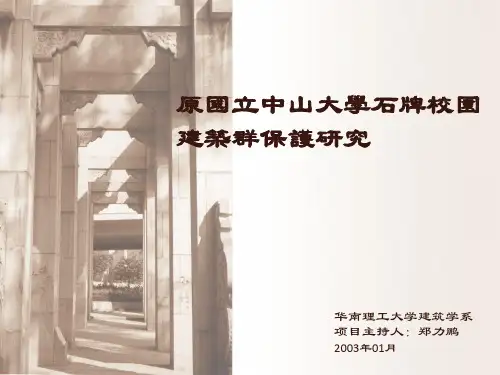
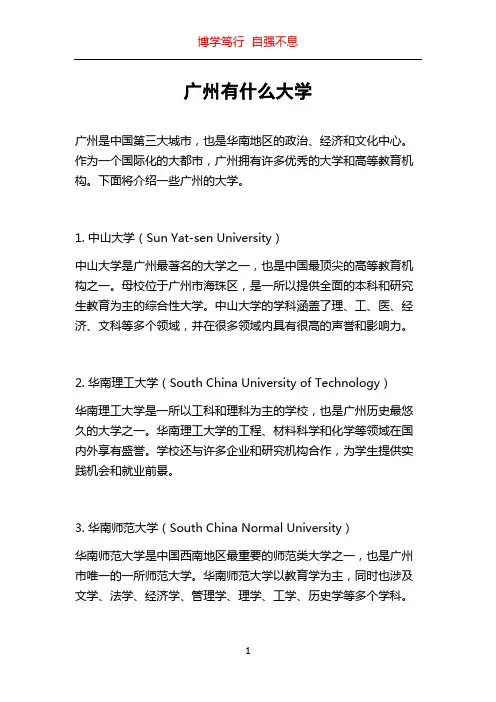
广州有什么大学广州是中国第三大城市,也是华南地区的政治、经济和文化中心。
作为一个国际化的大都市,广州拥有许多优秀的大学和高等教育机构。
下面将介绍一些广州的大学。
1. 中山大学(Sun Yat-sen University)中山大学是广州最著名的大学之一,也是中国最顶尖的高等教育机构之一。
母校位于广州市海珠区,是一所以提供全面的本科和研究生教育为主的综合性大学。
中山大学的学科涵盖了理、工、医、经济、文科等多个领域,并在很多领域内具有很高的声誉和影响力。
2. 华南理工大学(South China University of Technology)华南理工大学是一所以工科和理科为主的学校,也是广州历史最悠久的大学之一。
华南理工大学的工程、材料科学和化学等领域在国内外享有盛誉。
学校还与许多企业和研究机构合作,为学生提供实践机会和就业前景。
3. 华南师范大学(South China Normal University)华南师范大学是中国西南地区最重要的师范类大学之一,也是广州市唯一的一所师范大学。
华南师范大学以教育学为主,同时也涉及文学、法学、经济学、管理学、理学、工学、历史学等多个学科。
4. 中山医学院(Sun Yat-sen University, Zhongshan School of Medicine)中山医学院是中山大学的医学部,也是广州最好的医学院之一。
学校成立于1865年,拥有悠久的历史和优秀的师资和教育资源。
中山医学院在医学、临床医学和生物医学工程等领域具有很高的学术声誉,并在培养医学专业人才方面扮演了重要角色。
5. 广州大学(Guangzhou University)广州大学是广东省属重点支持建设的综合性大学,也是广州市的一所著名高校。
学校设有各种本科和研究生专业,包括工科、理科、文科、管理学等。
广州大学以其卓越的教学和研究水平受到学生和企业的赞誉。
除了以上几所大学,广州还有许多其他的高等教育机构和大学。
Sun Yat-sen UniversitySun Yat-sen University or Zhongshan University (Traditional Chinese: 中山大学; Simplified Chinese : 中山大学; pinyin: Zhōngshān Dàxué) is a prominent university in the southern part of China, located mainly in Guangzhou. The university is named after Dr. Sun Yat-Sen, a physician and later president of the Republic of China.The university consists of 4 campuses (South Campus, North Campus, East Campus and Zhuhai Campus) with a total area of 6.17 square kilometers. Three of the four campuses are located in Guangzhou, the fourth is in Zhuhai.The university motto, "Study extensively; Enquire accurately; Reflect carefully; Discriminate clearly; Practise earnestly" (博学、审问、慎思、明辨、笃行), is from one of the Chinese classics, Doctrine of the Mean.Sun Yat-sen University, originally known as National Kwangtung University (国立广东大学), was founded in 1924 by Dr. Sun Yat-sen. It combined National Higher Normal College (广东高等师范学校), Kwangtung Provincial Law College (广东公立法科大学) and Provincial Agricultural Technical School (广东公立农业专门学校), and after his death it was renamed National Sun Yat-sen University in 1926.CampusThe campus was originally located at Shipai (石牌), Eastern Guangzhou. In the early 1950s, Sun Yat-sen University was merged with Lingnan University and relocated to Kangle Yuan (康乐园), Southern Guangzhou, which is now called the South Campus. In 2000, the Zhuhai Campus was established in Tangjia (唐家), city of Zhuhai. In 2001, the former Sun Yat-sen University of Medical Sciences merged into Sun Yat-sen University, constituting the current North Campus. The East Campus was established in 2004 in Guangzhou Higher Education Mega Center (广州大学城), Panyu, Guangzhou.AcademicsSun Yat-Sen University of Medical SciencesSun Yat-sen University is a comprehensive university including the humanities, social sciences, natural sciences, technical science, medical science, pharmacology and managementscience. There are 23 schools and colleges, including a medical school, a school of dental medicine, a law school and a business school.In the graduate study programmes there are 17 disciplines leading to Doctorate and/or Master degrees, of which 146 specialties lead to a Doctorate degree and 205 specialties lead to a Master degree. In addition, there are 12 branches of studies leading to professional degrees, which are: Doctor of Medicine, Master of Business Administration (MBA), Master of Public Administration (MPA), Master of Judicial Studies (LL.M.).2Founded in 1924 by Dr. Sun Yat-sen— a great leader of the 20th century, Sun Yat-sen University is a vibrant community of scholarship and learning characterized by its revolutionary spirit. The mission of SYSU is to advance knowledge and educate students in arts, science, technology, and other academic areas that will best serve the nation and the world in the 21st centurySun Yat-sen University is located in Guangdong Province, the frontal of reform and opening. At present the University has 4 campuses with a total area of 6.17 square kilometers sitting respectively on both sides of the Pearl River or facing the South China Sea. The Guangzhou South Campus covers an area of 1.17 square kilometers, the North Campus covers an area of 0.39 square kilometers, and the Zhuhai Campus covers an area of 3.48 square kilometers. All campuses have exuberance of green trees, abundance of lawns and beautiful sceneries, and are ideal for molding the temperaments, studying and doing research. The Guangzhou East Campus has an area of 1.13 square kilometers and is now under construction.A long history and fine traditionSun Yat-sen university is a name-brand institution of higher education with fine traditions in teaching and learning. In 1924, Dr. Sun Yat-sen, great leader of the 20th century, founded this university personally, and inscribed in his own handwriting the school motto of "Study extensively; Enquire accurately; Reflect carefully; Discriminate clearly; Practise earnestly." The school was originally named Guangdong University, and later renamed Sun Yat-sen University in 1926. In the 1930s, there were seven schools in the University, which were the Schools of Arts, Sciences, Law, Engineering, Agricultural Studies, Medicineand Education. In 1935, the University set up the Graduate School and began to enroll graduate students. In the 1950s, the colleges, schools and departments were readjusted nationwide, and Sun Yat-sen University became a comprehensive university with the liberal arts and sciences as its backbone disciplines. Since the founding of the new China, Sun Yat-sen University has always been one of national key universities, and is also among the first batch of institutes to award Doctorate and Master degrees and to establishpost-doctoral research flowing stations in our country. Approved by the State Council, the university was the first to set up graduate school in the South China area in the early 1990s, thus offering a complete range of degrees from the bachelor, master to doctorate.The University has been unceasingly raising the quality of undergraduate education and has become an important base for training high-level talents. On the occasion of its 70th anniversary, President Jiang Zemin wrote the inscription of "Develop Dr. Sun Yat-sen's revolutionary spirit, manage the University better and make greater contributions" which further points out the direction for running schools. In September 2000, the Zhuhai Campus of Sun Yat-sen University in Tang Jia Wan, Zhuhai city, was completed, which expands the space and lays a solid foundation for development in the new century. On October 26, 2001, Sun Yat-sen University and the Sun Yat-sen University of Medical Science were merged to form the new Sun Yat-sen University. The Ministry of Education and the government of Guangdong Province signed an agreement, both promising to invest 1.2 billion RMB in 3 years to build the new Sun Yat-sen University into a first class university with high academic standards.One of the predecessors of the Sun Yat-sen University of Medical Science was the Bo Ji Medical School, which, founded in 1866, was the earliest institution of learning of western medicine in our country, where Dr.Sun Yat-sen once studied and engaged in revolutionary activities. The Bo Ji Medical School evolved into the College of Medicine of Lingnan University in 1936. In 1953, the Colleges of Medicine in Sun Yat-sen University and Lingnan University merged to form the College of Medicine of South China, which was joined by the Guangdong Guanghua College of Medicine in 1954. The university was renamed Guangzhou College of Medicine and Sun Yat-sen College of Medical Science successively, and finally Sun Yat-sen University of Medical Science in 1985, which has developed steadfastly into a comprehensive medicaluniversity with multi-schools and multiple levels, has reached national advanced level and achieved remarkable successes in scientific research in medical genetics, ophthalmology, tumor study, parasite study, the kidney disease of internal medicine, organ transplant, infectious liver disease, biological medical project and molecular medical science.Sun Yat-sen University and the Sun Yat-sen University of Medical Science have rich historical origin and common academic heritage. Many experts and scholars well-known at home and abroad have taught in Sun Yat-sen University, among them are Lu Xun, Guo Moruo, Feng Youlan, Fu Sinian, Zhao Yuanren, Gu Jiegang, Zhou Gucheng, Yu Pingbo, Chen Yinque, Cen Zhongmian, Jiang Lifu, Wang Yanang, Ma Cai, Rong Geng, Shang Chengzuo, Wang Jisi, Wang Li, Zhong Jinwen, Zhu Qianzhi, Ding Ying, Pu Zhelong, etc. Many famous medical experts have taught in the Sun Yat-sen University of Medical Science, such as Ke Lin, Liang Boqiang, Xie Zhiguang, Chen Xintao, Chen Yaozhen, Qin Guanyu, Lin Shumo, Zhou Shoukai, Zhong Shifan, Mao Wenshu and Chen Guozhen. Famous scholars and great masters have been gathering at the university to nurture generation after generation of students and to cultivate fine academic vogue, and many gifted graduates have become outstanding figures in all walks of life.After the reform and opening up of our country and driven by the rapid economic growth in Guangdong province, the original Sun Yat-sen University and Sun Yat-sen University of Medical Science have carried out a series of educational reforms and achieved substantial development. Starting from 1993, The Ministry of Education, Department of Health and People's Government of Guangdong province contributed jointly in building the then Sun Yat-sen University and Sun Yat-sen University of Medical Science. In the recent years, both universities have passed the acceptance inspection of the "211 projects"; the various projects of disciplinary development, public service systems and infrastructure construction have been completed smoothly. The merger of the two universities is an amalgamation of two strong institutes, making the syllabus designs more complete and the faculties more comprehensive.Educational resources and disciplinary advantagesAt present, Sun Yat-sen University is a comprehensive university including thehumanities, social sciences, natural sciences, technical science, medical science, pharmacology and management science. There are 25 schools and colleges, including the School of Humanities, Lingnan College, School of Foreign Languages, School of Law, School Political Science and Public Administration, School of Business, School of Education, School of Communication and Design, School of mathematics and Computational Science, School of Physics and Engineering, School of Chemistry and Chemical Engineering, School of Geology and Planning, School of Environmental Science and Project, School of Life Science, School of Information Science and Technology, School of Engineering, School of Oversea Education Exchange, Sun Yat-sen Medical College, School of Fundamental Medicine, School of Public Health, Guanghua School of Stomatology, Nursing School, School of Pharmacology, as well as the Department of Earth Science, the Graduate School, School of Software, School of Network Education, College of Continuing Education, etc.Sun Yat-sen University offers a wide variety of subject areas and complete disciplines. In the programs of graduate studies, there are 22 disciplines leading to Doctorate degrees and 32 to Master degrees, of which 171 specialties lead to Doctorate degree, 236 specialties lead to Master degree; in addition, there are 17 branches of studies leading to professional degrees, which are: Doctorate degree in clinical medicine, Master of business administration (MBA), Master of public administration (MPA), Master of judicial studies (JD), Master of computer technology, Master of environmental project, Master of software engineering, Master of electronic and communication engineering. and Master of biology engineering . The University has 12post-doctorate research floating stations of Chinese language and literature, history, mathematics, physics, chemistry, biology, fundamental medical science, clinical medical science, management, public management, philosophy, environmental science and engineering; 20 key disciplines at the national level and 43 key disciplines at Guangdong provincial level. In undergraduate education, there are 89 specialties in undergraduate programs, with 6 national bases of fundamental sciences research and training, such as philosophy, Chinese language and literature, history, physics, chemistry and biology, 25 undergraduate specialties of name-brand specialties at the provincial-level. There are also the national bases of education in cultural qualities for college students and the first athletic training base for college student in China. In this year, the number of students of all types amounts to70000,of which 3800 are doctorate candidates, 13000 are graduate students, 28000 are undergraduate students, and 1100 are international students. Sun Yat-sen University has abundant qualified faculty members. The university has the right to evaluate and confer the titles of full professor and associate professor. There are 12000 faculty and staff members, of which 805 are Ph D candidate supervisors, over 860 are full professors, 1500 are associate professors. Outstanding talented persons keep coming forth from the faculties, there are 13 academicians of the Chinese Academy of Sciences and 4 academicians of the Chinese Academy of Engineering, 15 young andmiddle-aged experts with outstanding contributions at the national level, 37 recipients of national fund for outstanding young scientists, 19 persons selected in the first and second rounds of the "project of talent selection" by the Ministry of Personnel, 19 candidates chosen for the "plan of training excellent scholars for the new century" by the Ministry of Education, 16 professors specially accredited with the "Yangtze Scholar Scheme" of the Ministry of Education, and 16 experts with outstanding contributions selected by the Department of Health.The university has a batch of laboratories and research bases with advanced standards and complete facilities. At present, there are 6 national key laboratories, 6 key laboratories designated by the Ministry of Education, 6 key research bases in the humanities designated by the Ministry of Education, 3 key laboratories designated by the Ministry of Health, and 10 key laboratories designed by Guangdong province.The University library has a collection of 4,988,000 volumes. In addition to the traditional services of circulation of books and periodicals, X-copying and quick printing, it also offers various forms of electronic information service, such as internet browsing, database retrieval on compact disk, network database retrieval, DIALOG retrieval on line, UnCover service of special subjects and electronic document transmission, making it convenient for the faculty and students to access electronic resources promptly and efficiently. The library of Sun Yat-sen University has been assigned by the Ministry of Education as the center for storing documents of higher education in South China, one of the 7 centers of the higher education document guarantee system in China. Campus networks on considerably large scale have been established on the three campuses of the University, and the connection speed between the campuses has reached gigabites; fiber cable connection has been established betweenteaching buildings, office buildings, student dormitories and staff residences, with a total length of cable exceeding 200 kilometers and over 31000 users. The scale of campus network and the number of users are ranked first among universities and colleges in South China, and the campus network is one of the networks in the country that cover the widest area, with the largest scale, the most advanced technology, and the fastest outlet speed, laying a good foundation for raising the overall level of teaching, research and management.The university has four comprehensive affiliated hospitals, namely, the First University Hospital, Second University Hospital (Sun-Yat-sen Memorial Hospital), Third University Hospital and fifth University Hospital (Zhuhai Hospital), as well as Sun Yat-sen Ophthalmology Center (including the Ophthalmology Hospital), the Center of Prevention and Cure of Cancer (including the Cancer Hospital), and Guanghua Stomatological Hospital.Sun Yat-sen University is located in Guangdong, neighboring Hongkong and Macao, and is active in international academic exchange. The merge with Sun Yat-sen University of Medical Science has brought a wider range of fields in international exchange. The University has established academic exchange with more than 100 well-known universities, academic institutes and societies in countries and areas of America, Canada, Japan, Australia, England, France and Germany, and has signed exchange agreements with 40 of them. Since reform and opening-up, the alumni at home and abroad have given SunYat-sen University vigorous supports by donating money for teaching, research and residential buildings, instruments and apparatus; for all kinds of books and reference and for establishing awards. The amount of all kinds of donation reaches more than 4.5 hundred million yuan.Characteristics and splendid achievementsStriking characteristics in education have been developed in almost 80 years of the history of Sun Yat-sen University, of which the most outstanding are being open, scientific and revolutionary.Sun Yat-sen university was founded for the purpose of training revolutionaries. Dr. Sun Yat-sen's mottos of "Serving the public" and "We have not succeeded in revolution and should continue to endeavour" have been encouraging everyone in the University. Leading officials of the previous times all attachedimportance to education of patriotism and personal integrity, emphasized the national spirit, and cultivated ideas of the state and ethics. Following Dr. Sun Yat-sen's example and taking his revolutionary ideas as the guiding theory in running the school, the university has graduated large quantities of excellent talents and fostered a fine tradition of shouldering the responsibility of defending the country and building the nation in the past 80 years. In his inscription to the university, Jiang Zemin, the General Secretary of the Party, called on the faculty and students to "carry on the revolutionary spirit of Dr. Sun Yat-sen.", which was indeed an appropriate summary of the revolutionary tradition of Sun Yat-sen University.The history of Sun Yat-sen University has been closely associated with a batch of professors and scholars of great masters, whose ideas and methods of study and research have fostered the fine tradition of emphasizing the "scientific nature". In the school tenet of the university, it has been set as the goal to develop teaching and research, and to strive to be a famous university since the beginning. The scientific laws of stressing the foundation, quality, and talent training have become the tradition of teaching and learning in Sun Yat-sen University. Professor Chen Yinqie, a renowned master of the national classics, was proficient in a dozen languages, including Sanskrit, and had made outstanding accomplishments in history, religion, linguistics, textual research, cultural study and the fields such as Chinese classical literature. Mr. Chen devoted himself to doing genuine studies and did not seek undeserved reputation, insisting on "three don'ts" in academic research: don't lecture according to the book; don't mimic what others have talked; and don't repeat what is said before even by himself. He persisted in lecturing on the problems that were discovered in academic research, as well as the exploration and thinking in the process of solving these problems. The scientific style of teaching by concrete examples and the discreet manner in research, the courage in exploring new academic fields have left a lot of spiritual wealth to the scientific shrine of Sun Yat-sen University.Sun Yat-sen University, the well-known Chinese university created by Dr. Sun Yat-sen, has entered the fast lane of accelerated development. To build the University into a high-level research-type comprehensive university ranked on top of universities in the country and with greater influence in the world, all faculties, employees and students are filled with confidence in inheriting the tradition and moving ahead, and are of one heart and one mind in marchingforward with time and exploiting and creating the new world. In the new century, Sun Yat-sen University is sure to march victoriously and to attain ever-splendid successes.。
广州有哪几所211大学(2)份广州有哪几所211大学 1中山大学(Sun Yat-sen University, SYSU),简称“中大”,有着一百多年办学传统,是__南方科学研究、文化学术与人才培养的重镇。
中山大学由__教育部直属,__直管副部级建制,是教育部、国家国防科技工业局和广东省共建的全国重点大学,位列首批国家“双一流”A类、“985工程”、“211工程”,学校已经成为一所__一流、国际知名的`现代综合性大学,正努力成为全球学术重镇。
华南理工大学(South China University of Technology),简称华南理工,位于广东省广州市,创建于1934年,是__教育部直属的全国重点大学,国家国防科技工业局与教育部共建高校,首批“世界一流大学建设高校”、“211工程”、“985工程”重点建设院校之一,是以工见长,理工结合,管、经、文、法、医等多学科协调发展的综合性研究型大学。
暨南大学是__第一所由__创办的华侨学府。
“暨南”二字出自《尚书·禹贡》:“东渐于海,西被于流沙,朔南暨,声教讫于四海。
”意即面向南洋,将__文化远播到五洲四海。
学校目前是__、教育部、广东省共建的国家“双一流”建设高校,直属__管理。
作为__历史最悠久的大学之一,暨南大学在__高等教育史上有着重要地位:第一所由国家创办的华侨高等学府,校名一直沿用的百年名校之一,全国首批试行学分制的高校,最早在综合性大学里开办医学院的大学,最早设立华侨华人问题研究机构的大学,最早创设商科的大学。
华南师范大学始建于1933年,前身是广东省立勷勤大学师范学院。
是国家“211工程”重点建设大学、省部共建高校、广东省高水平大学整体建设高校和国家“一流学科”建设高校。
学校现有广州石牌、广州大学城和佛山南海3个校区。
立足新发展阶段,学校将坚持和加强*对高校的全面__,坚持__办学方向,坚持立德树人根本任务,贯彻落实“教师教育出特色、学科水平__阶”办学思路,积极打造人才队伍高地和科研创新高地,深入实施国际化和信息化发展战略,全面深化综合__,大力推进内涵发展,加快“教师教育优势突出的创新型高水平大学”建设步伐。
中山大学历年排名情况_中山大学排名中山大学历年排名情况中山大学2021年的全国排名是第15名,2020年的全国排名是第14名,下中山大学在广东省大学排名中山大学在广东排名是第1,排名第二的则是华南理工大学。
其他排名信息请看下表:中山大学有哪些校区中山大学有广州校区、珠海校区、深圳校区三个校区。
其中,广州校区又分为三个校园,分别是东校区、北校区和南校区。
中山大学拥有10家直属附属医院(其中7家综合医院,3家专科医院)。
广州校区南校区位于广州市海珠区新港西路135号,院系设置有中国语言文学系、历史学系、哲学系、社会学与人类学学院、博雅学院、岭南学院、外国语学院、马克思主义学院、数学学院、物理学院、地理科学与规划学院、生命科学学院、逸仙学院、体育部、艺术学院。
广州校区北校区位于广州市越秀区中山二路74号,院系设置有中山医学院、光华口腔医学院、公共卫生学院、护理学院。
广州校区东校区位于广州市番禺区大学城外环东路132号,院系设置有法学院、政治与公共事务管理学院、管理学院、心理学系、传播与设计学院、资讯管理学院、工学院、化学学院、材料科学与工程学院、电子与信息工程学院、数据科学与计算机学院(软件学院)、国家保密学院、网络安全学院、环境科学与工程学院、系统科学与工程学院、药学院。
珠海校区位于珠海市香洲区唐家湾,院系设置有中国语言文学系(珠海)、历史学系(珠海)、哲学系(珠海)、国际金融学院、国际翻译学院、国际关系学院、旅游学院、数学学院(珠海)、物理与天文学院、大气科学学院、海洋科学学院、地球科学与工程学院、化学工程与技术学院、海洋工程与技术学院、中法核工程与技术学院、土木工程学院、微电子科学与技术学院、测绘科学与技术学院。
深圳校区位于深圳市光明新区,院系设置有医学院、公共卫生学院(深圳)、药学院(深圳)、材料学院、生物医学工程学院、电子与通信工程学院、智能工程学院、航空航天学院、农学院、生态学院。
高考志愿能多少个大学①新高考可以报几个学校几个志愿在实施高考综合改革的地区,不管是采用院校专业组还是专业+学校的模式,在志愿数量上都要比往年多很多。
中山大学 同类院校排行同地区院校排行
办 学 历 史 和 优 良 传 统
中山大学是由孙中山先生亲手创立,有着一百多年办学传统的综合性重点大学。今日的中山大学,由1952年院系调整后分设的中山大学和中山医科大学合并组建而成。 1835年,美国的伯驾医生在广州设立医局,培养了中国最早的西医医生,在此基础上建立了博济医院,并于1866年设立医学堂,这是中国最早的医学专科教育机构;1888年,由美国人开设的格致书院在广州开学,后发展为私立岭南大学,博济医院及其附设的医学校成为岭南大学医学院。博济医学堂和格致书院,开启了中国近代西式教育的先河。 1924年,孙中山先生亲手将清末以来在广州地区建立的实行近代教育模式的学校,包括国立广东高等师范学校、广东公立法科大学以及广东公立农业专门学校等整合为一体,创立国立广东大学,并亲笔题写校训:“博学、审问、慎思、明辨 、笃行”。孙中山先生逝世后,学校于1926年定名为国立中山大学。其后,广东公立医科大学、国立广东法科学院、广东省立勷勤大学工学院先后并入。至上世纪三十年代,国立中山大学设有文、理、法、工、农、医、师范等7个学院。1935年设立研究院,开始招研究生。 1952年全国院系调整后,原中山大学的多个院系专业被分出,其中文理科院系和岭南大学相关院系合并,组成新中山大学;同时,两校的医学院分出后,另行合并组建专门的医科院校,后又将广州的光华医学院并入,几经易名,最后定名为中山医科大学。这两所同根同源的大学,分别是教育部和卫生部直属的重点大学,共同继承了由革命先行者孙中山先生亲手创办的中山大学和开创中国近代教育体系的岭南大学的办学传统,形成了独特的办学特色和大学风格,为当代中国高等教育发展做出了重要的贡献。 2001年10月,原中山大学和和中山医科大学合并组建新的中山大学,进一步拓宽了学科结构, 成为一所包括人文科学、社会科学、自然科学、技术科学、工学、医学、药学、经济学和管理学等在内的综合性大学。 中山大学和中山医科大学有着深厚的历史渊源及学术传统。鲁迅、郭沫若、冯友兰、傅斯年、赵元任、顾颉刚、周谷城、俞平伯、陈寅恽岑仲勉、姜立夫、王亚南、马采、容庚、商承祚、王季思、王力、钟敬文、朱谦之、丁颖、蒲蛰龙等蜚声海内外的专家学者都曾在中山大学任教。柯麟、梁伯强、谢志光、陈心陶、陈耀真、秦光煜、林树模、周寿恺、钟世藩、毛文书、陈国祯、李绍珍等著名医学专家曾在中山医科大学任教。上个世纪五十年代,全国共有56位一级教授,其中有12位在原中山大学和中山医科大学任教。学校名家大师荟萃,他们优秀的品格和精湛的学术造诣熏陶着一代代莘莘学子,形成了良好的学术风气,许多才华横溢的毕业生成为了社会各界的杰出人才。
办 学 条 件 和 学 科 优 势 学校共有四个校区,总面积达6.17平方公里,分别座落在珠江之畔、南海之滨。广州南校区占地1.17平方公里,北校区占地0.39平方公里,广州东校区占地1.13平方公里,珠海校区占地3.48平方公里。 学校设有人文科学学院、中国语言文学系、历史学系、哲学系、人类学系、岭南学院、国际商学院、外国语学院、外语教学中心、国际交流学院、翻译学院、旅游学院、法学院、知识产权学院、政治和公共事务管理学院、亚太研究院、管理学院、教育学院、传播和设计学院、资讯管理系、数学和计算科学学院、物理科学和工程技术学院、化学和化学工程学院、地理科学和规划学院、地球科学系、环境科学和工程学院、生命科学学院、海洋学院、信息科学和技术学院、软件学院、工学院、中山医学院、公共卫生学院、光华口腔医学院、护理学院、药学院等30个学院和6个直属系。另设有附属第一医院、附属第二医院(孙逸仙纪念医院)、附属第 三医院、附属第五医院(珠海医院)、附属第六医院等5所综合性医院,以及中山眼科中心(含眼科医院)、肿瘤防治中心(含肿瘤医院)、光华口腔医院等3个附属专科医院。 学校现有98个本科专业,拥有哲学、中国语言文学、历史学、物理学、化学、生物学等6个国家级基础科学研究和教学人才培养基地及1个国家生命科学和技术人才培养基地,化学、基础医学、生物学、物理学等4个国家级实验教学示范中心,首批国家大学生文化素质教育基地,以及中国第一个大学生体育训练基地。截至2008年11月,在校各类学生中有博士研究生4305人、硕士研究生9786人,在职攻读硕士学位研究生5817人,本科生32020人,来自港澳台的在校学生1000多人,来自各个国家、地区的在校留学生1428人、进修生2300多人。 中山大学学科门类齐全,现有22个博士学位授权一级学科、32个硕士学位授权一级学科,博士学位授权点涵盖了180个学科专业,硕士学位授权点涵盖了251个学科专业,还有专业学位授权领域23个,博士后科研流动站23个。学校现有2个一级学科国家重点学科、23个二级学科国家重点学科,6个二级学科国家重点(培育)学科,以及11个一级学科广东省重点学科、23个二级学科广东省重点学科。 学校有一批水平先进、设施完善的实验室和科研基地。拥有“光电材料和技术”、“有害生物控制和资源利用”、“华南肿瘤学”、“眼科学”等4个国家重点实验室,“水生经济动物繁殖营养和病害控制”、“植物基因工程”等2个国家重点学科专业实验室,“南海海洋生物技术”国家工程研究中心以及“国家新药(抗肿瘤药物)临床试验”研究中心等国家级科研机构;拥有“聚合物复合材料及功能材料”、“基因工程”、“生物无机和合成化学”、“数字家庭”、“眼科学”、“肿瘤相关基因和抗肿瘤药物研究”、“热带病防治研究”、“干细胞和组织工程”等8个教育部重点实验室;有马克思主义哲学和中国现代化研究所、逻辑和认知研究所、港澳珠江三角洲研究中心、行政管理研究中心、历史人类学研究中心、中国非物质文化遗产研究中心等6个教育部人文社会科学重点研究基地以及5个广东省人文社会科学重点研究基地;并拥有眼科学实验室、肾脏病临床研究实验室、辅助循环实验室等3个卫生部重点实验室以及11个广东省重点实验室。 学校有着雄厚的师资力量。全校共有教职工12663人,其中博士生导师1052人,具有高级职 称的1000多人,具有副高职称的2000多人。教师队伍中杰出人才辈出,目前有中国科学院院士10人(含双聘)、中国工程院院士3人(含双聘),国家级教学名师奖获得者6名,国家级有突出贡献的中青年专家15人,国家杰出青年科学基金获得者44人,教育部“长江学者”特聘教授20人,“长江学者”讲座教授5人,国家人事部“百千万人才工程”第一、二层次人选22人,19人入选教育部“跨世纪优秀人才培养计划”,85人入选教育部“新世纪优秀人才支持计划”,卫生部突出贡献专家18人,霍英东青年教师基金获得者15人、霍英东青年教师奖获得者18人。 学校图书馆总建筑面积11万余平方米,藏书529.63万册(件),新书刊资料年增长量达8万余件。学校建立了规模可观的校园网,覆盖四个校区、接入计算机达5万余台,规模居中国高校校园网前列。
办 学 特 色 和 培 养 模 式 学校以“善待学生”为办学的核心理念,以培养具有国际视野、满足国家和社会需求的高素质复合型拔尖创新人才为目标。 学校秉承孙中山先生 “博学、审问、慎思、明辨、笃行”的校训精神开展本科教育。注重通识教育,注重培养人才的综合素质,提倡脚踏实地的学术精神和学以致用的实践能力。逐步探索形成了“通识教育、大类教学、复合创新”的本科人才培养教育观念和“厚基储宽口径、重个性、求创新”的人才培养特色。 学校研究生教育积极推进分类培养,建立多元化培养体系,以培养具有强烈创新意识并做出创新性成果的博士为研究生教育的首要任务,同时以行业为背景,大力发展专业学位教育,培养高级实用型专门人才。 学校坚持“课堂教学、校园文化、社会实践”三位一体的人才培养模式,提倡人文精神和科学精神的结合,开展以传承大学文化为主体的多层次素质教育,构建了具有综合性大学特色的素 质教育课程体系。发挥团学组织“一体两翼”的运作优势,积极构建高品位、前瞻性、开放式、互动型的校园文化新格局。 学校启动国际交换生培养计划,促进学生境外交流,全面引进优质教学资源,搭建国际化教学平台,迄今和28个国家和地区的152所院校建立了校级友好协议合作关系。2005年至2008年,派出交流学生累计超过500名。 学校设立了“中山大学学生创意基金”和“本科生科研专项基金”,鼓励学生早期介入科研。2004年至2008年,在校学生在各学科竞赛中多次获奖,包括“挑战杯”全国竞赛优胜杯、ACM国际决赛的银牌和铜牌,美国数学建模竞赛中获国家级奖66人,全国数学建模竞赛中获国家级奖66人。在ACM国际大学生程序设计竞赛(ACM/ICPC)全球总决赛中,我校一直是中国六所传统强校之一,共9次冲出亚洲走向世界;继2002年我校学生辩论队获全国大专辩论赛冠军之后,2003年代表中国参加国际大专辩论赛勇夺冠军;2003年在香港举行的第四届投资策划ACCA大学生公开赛中,我校代表队夺得冠军;2007年,我校环境科学和工程学院叶泉志同学因在业余天文搜索和观测中发现不少小行星而获得由国际行星协会公布的苏梅克近地天体奖。
科 研 实 力 和 社 会 服 务 “十五”以来至2008年,学校承担的国家重点基础研究发展规划项目(973项目)4项,主持国家863计划资助项目共139项,承担国家自然科学基金重点项目40项;在人文社科领域,承担国家、教育部重大、重点项目及招标课题87项,2005年至2008年,承担国家社科基金重大招标项目1项,教育部哲学社科重大课题攻关项目5项、教育部重点研究基地招标项目53项,国家哲学社科基金项目重点及一般项目91项。"十五"期间全校共获省部级以上科技奖励166项,其中,2项国家自然科学奖二等奖、5项国家科技进步二等奖,14项研究分别获中